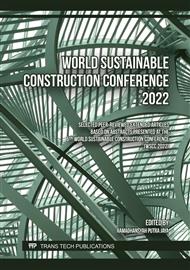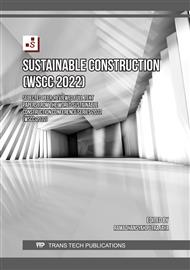[1]
N. F. A. A. Musa, M. Y. Aman, M. N. M. Taher, and Z. Noranai, "Utilization of Synthetic Reinforced Fiber in Asphalt Concrete – a Review," International Journal of Civil Engineering and Technology (IJCIET), vol. 10, no. 5, p.678–694, 2019.
Google Scholar
[2]
M. I. Saikhon, K. A. Masri, A. K. Arshad, S. M. Shahnewaz, and R. Ferdaus, "Evaluation of Flexible Pavement Distresses due to Undesirable Commercial Vehicles Activity," IEEE, 2021.
DOI: 10.1109/icoten52080.2021.9493451
Google Scholar
[3]
C. J. Slebi-Acevedo, P. Lastra-González, P. Pascual-Muñoz, and D. Castro-Fresno, "Mechanical performance of fibers in hot mix asphalt: A review," Constr Build Mater, vol. 200, p.756–769, 2019.
DOI: 10.1016/j.conbuildmat.2018.12.171
Google Scholar
[4]
P. J. Carreau, M. Bousmina, and F. Bonniot, "The viscoelastic properties of polymer-modified asphalts," Can J Chem Eng, vol. 78, no. 3, p.495–503, Jun. 2000.
DOI: 10.1002/CJCE.5450780308
Google Scholar
[5]
H. Busching, J. A.-A. A. P. T. Proc, and undefined 1968, "Fiber reinforcement of bituminous mixtures," trid.trb.org.
Google Scholar
[6]
E. Shaffie, A. K. Arshad, R. Putra Jaya, K. A. Masri, and W. Hashim, "Permanent deformation investigation of rubber polymer modified binder in superpave hot mix asphalt mixture / Ekarizan Shaffie... [et al.]," 2020.
DOI: 10.3390/su15043476
Google Scholar
[7]
L. M. G. Klinsky, K. E. Kaloush, V. C. Faria, and V. S. S. Bardini, "Performance characteristics of fiber modified hot mix asphalt," Constr Build Mater, vol. 176, p.747–752, 2018.
DOI: 10.1016/j.conbuildmat.2018.04.221
Google Scholar
[8]
A. Behnood and M. Modiri Gharehveran, "Morphology, rheology, and physical properties of polymer-modified asphalt binders," Eur Polym J, vol. 112, no. October 2018, p.766–791, 2019.
DOI: 10.1016/j.eurpolymj.2018.10.049
Google Scholar
[9]
N. F. Ghaly, "Combined effect of polypropylene and styrene-butadiene styrene on asphalt, and asphalt mixture performance," Journal of Applied Sciences Research, 4(11), 1297-1304., 2008.
Google Scholar
[10]
S. M. Abtahi, M. Ghorban Ebrahimi, M. M. Kunt, S. Mahdi Hejazi, and S. Esfandiarpour, "Production of polypropylene-reinforced asphalt concrete mixtures based on dry procedure and superpave gyratory compactor," 2011.
Google Scholar
[11]
A. A. Ramezanianpour, M. Esmaeili, S. A. Ghahari, and M. H. Najafi, "Laboratory study on the effect of polypropylene fiber on durability, and physical and mechanical characteristic of concrete for application in sleepers," Constr Build Mater, vol. 44, p.411–418, 2013.
DOI: 10.1016/j.conbuildmat.2013.02.076
Google Scholar
[12]
M. J. Kim, S. Kim, D. Y. Yoo, and H. O. Shin, "Enhancing mechanical properties of asphalt concrete using synthetic fibers," Constr Build Mater, vol. 178, p.233–243, 2018.
DOI: 10.1016/j.conbuildmat.2018.05.070
Google Scholar
[13]
R. Ferdaus, K. A. Masri and P. J. Ramadhansyah, "Sustainable Use of Polymer in Asphalt Mixture: A Review," CONSTRUCTION, vol. 2, no. 2, p.12–21, Oct. 2022.
DOI: 10.15282/CONSTRUCTION.V2I2.7744
Google Scholar
[14]
BJ Putman, "Effects of fiber finish on the performance of asphalt binders and mastics," hindawi.com, 2011.
Google Scholar
[15]
M. J. Kim, S. Kim, D. Y. Yoo, and H. O. Shin, "Enhancing mechanical properties of asphalt concrete using synthetic fibers," Constr Build Mater, vol. 178, p.233–243, Jul. 2018.
DOI: 10.1016/J.CONBUILDMAT.2018.05.070
Google Scholar
[16]
J. Roesler, A. Bordelon, A. Brand, and A. Amirkhanian, Fiber-Reinforced Concrete for Pavement Overlays, vol. 5, no. April. 2019.
Google Scholar
[17]
L. Brasileiro, F. Moreno-Navarro, R. Tauste-Martínez, J. Matos, and M. del C. Rubio-Gámez, "Reclaimed polymers as asphalt binder modifiers for more sustainable roads: A review," Sustainability (Switzerland), vol. 11, no. 3, p.1–20, 2019.
DOI: 10.3390/su11030646
Google Scholar
[18]
N. Z. Habib, I. Kamaruddin, M. Napiah, and I. Mohd Tan, "Rheological properties of polyethylene and polypropylene modified bitumen," World Acad Sci Eng Technol, vol. 72, p.293–297, 2010.
Google Scholar
[19]
Y. Becker, M. P. Méndez, and Y. Rodríguez, "POLYMER MODIFIED ASPHALT".
Google Scholar
[20]
J. Ahmad, M. R. Hainin, E. Shaffie, K. A. Masri, and M. A. Shaffi, "Effect of Temperature on Phase Angle and Dynamic Modulus of Asphalt Mixtures Using SPT," Materials Science Forum, vol. 1007, p.99–104, 2020.
DOI: 10.4028/WWW.SCIENTIFIC.NET/MSF.1007.99
Google Scholar
[21]
M. J.K.R, "STANDARD SPECIFICATION FOR ROAD WORKS - SECTION 4 | Kementerian Kerja," JKR Malaysia, 2008.
Google Scholar
[22]
A. I. Al-Hadidy and T. Yi-qiu, "Mechanistic approach for polypropylene-modified flexible pavements," Mater Des, vol. 30, no. 4, p.1133–1140, 2009.
DOI: 10.1016/j.matdes.2008.06.021
Google Scholar
[23]
C. N. C. W. Haryati Yaacoba, Moazzam Ali Mughala, Ramadhansyah Putra Jayaa, Mohd Rosli Hainina, Dewi Sri Jayantib, "RHEOLOGICAL PROPERTIES OF STYRENE BUTADIENE RUBBER MODIFIED BITUMEN BINDER," vol. 2, p.121–126, 2016.
Google Scholar
[24]
B. S. Hadavand, "Bitumen Modification with Polysulphide Polymer Prepared from Heavy End Waste," 2010.
Google Scholar
[25]
X. Lu, U. I.-C. and B. materials, and undefined 2002, "Effect of ageing on bitumen chemistry and rheology," Elsevier.
Google Scholar
[26]
L. M. G. Klinsky, K. E. Kaloush, V. C. Faria, and V. S. S. Bardini, "Performance characteristics of fiber modified hot mix asphalt," Constr Build Mater, vol. 176, p.747–752, Jul. 2018.
DOI: 10.1016/J.CONBUILDMAT.2018.04.221
Google Scholar
[27]
D. J. Read and D. W. David, "The Shell Bitumen Handbook," Asphalt Product EXHIBIT 1008, no. 7, 1990.
Google Scholar
[28]
K. Elias Kaloush, K. Prapoorna Biligiri, W. Abdelaziz Zeiada, M. Carolina Rodezno, and J. Xavier Reed, "Evaluation of Fiber-Reinforced Asphalt Mixtures Using Advanced Material Characterization Tests," 2010.
DOI: 10.1520/jte102442
Google Scholar



